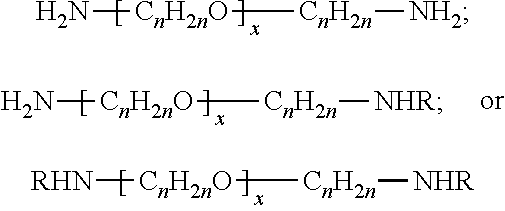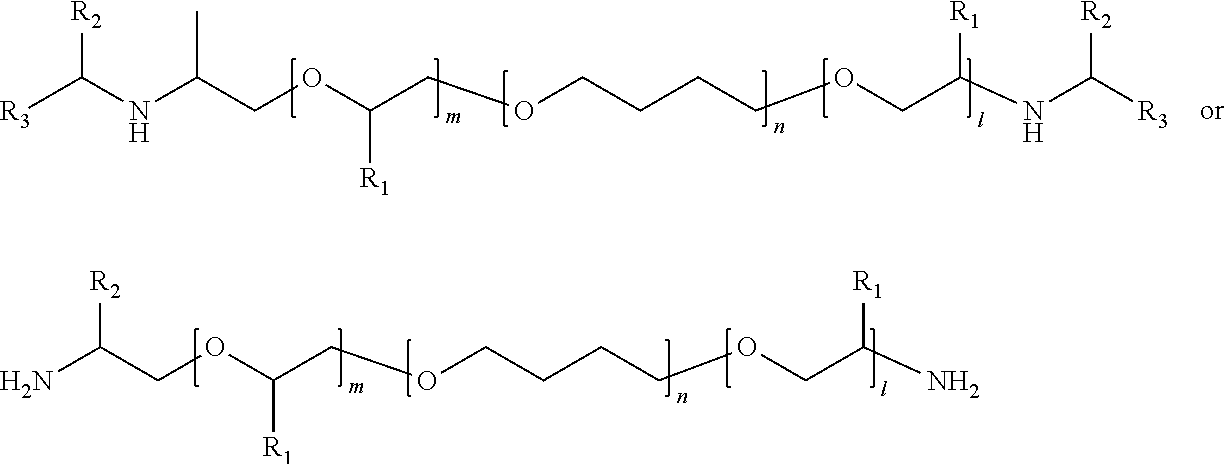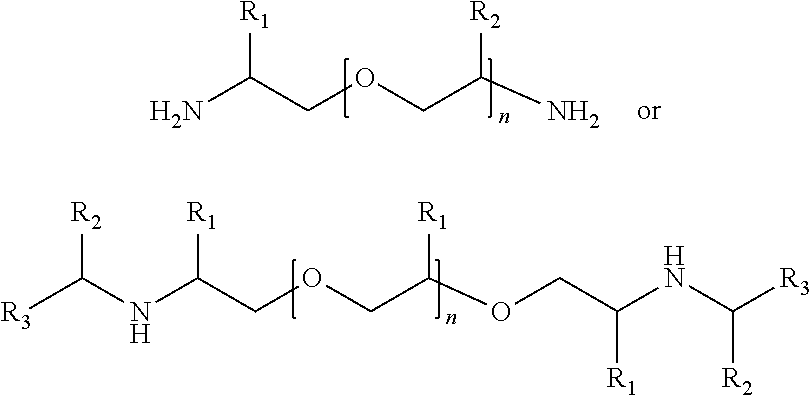Polyurethane compositions having improved impact resistance and optical properties
a technology of polyurethane and optical properties, applied in the field of polyurethane, can solve the problems of insufficient optical performance, insufficient impact strength and crack resistance, poor chemical, solvent, scratch resistance,
- Summary
- Abstract
- Description
- Claims
- Application Information
AI Technical Summary
Benefits of technology
Problems solved by technology
Method used
Image
Examples
example 1
[0072]The following are combined, melted and mixed well: 36.05 grams (g) of TONE™ 32B8, 6.83 g of TONE™ 32C8, 10.63 g of TONE™ 1278, and 0.58 g of trimethylolpropane. The mixture is then added slowing to 3-neck glass flask containing 45.90 g of Isocyanate 2 with agitation. The temperature of the reactor is then slowly raised to 90 degrees Celsius (° C.) and the reaction is kept at 90° C. in a dry nitrogen atmosphere for 6 hours. At the end of that time, the reaction product is a prepolymer having an NCO content of 10.75 percent.
[0073]The prepolymer reaction product is then degassed and cooled to 65° C. to 70° C., and 100 g are mixed with 21.62 g of ETHACURE™ 100 LC on a speed mixer for 30 seconds and poured into a mold that has been preheated at 115° C. This forms sample sheets that are 3 mm in thickness. The mold is then placed in an oven set at 115° C. Following cure at 115° C. for 10 minutes, the sample sheet is removed from the mold and postcured at 115° C. for an additional 16 ...
example 2
[0075]An additional 100 g of the prepolymer prepared in Example 1 is mixed with 45.45 g of LONZACURE™ MCDEA, melted at 100° C. on a speed mixer for 30 seconds, and poured into a mold that has been preheated at 130° C. This forms sheets having a thickness of 3 mm The mold is then placed in an oven set at 130° C. Following cure at 130° C. for 30 minutes, the sample sheet is removed from the mold and postcured at 130° C. for an additional 16 hours.
[0076]The sample sheet is then kept at room temperature for 7 to 10 days before it is subjected to tests for haze, luminous transmittance and impact resistance. The results are shown in Table 1.
examples 3 and 4
, and Comparative Examples E and F
[0084]Specimens of approximately 9 millimeters (mm) by 30 mm are cut from the resulting 3 mm thick plaques. All specimens are prepared according to guidelines of the testing methods.
[0085]Specimens for refractive index are subjected to polishing via several grades of sandpaper and then fine paper, to a grit level of 1200. The polished samples are tested on an Atago DR M2 / 1550 Abbe refractometer for the refractive index at 20° C. and at a variety of wavelengths. The data are fitted to the Cauchy formula using a “least squares method,” and the fitted equation is then used to determine the refractive index of each material at 656.3 nanometers (nm). The Abbe number for each material is then calculated according to the equation:
AbbeNumber=nD-1nF-nC
where nD is the refractive index at 589 nm, nC is the refractive index at 656.3 nm, and nF is the refractive index at 486 nm.
[0086]The original plaques are rested for scratch resistance usin...
PUM
| Property | Measurement | Unit |
|---|---|---|
| Time | aaaaa | aaaaa |
| Percent by mass | aaaaa | aaaaa |
| Percent by mass | aaaaa | aaaaa |
Abstract
Description
Claims
Application Information
 Login to View More
Login to View More - R&D
- Intellectual Property
- Life Sciences
- Materials
- Tech Scout
- Unparalleled Data Quality
- Higher Quality Content
- 60% Fewer Hallucinations
Browse by: Latest US Patents, China's latest patents, Technical Efficacy Thesaurus, Application Domain, Technology Topic, Popular Technical Reports.
© 2025 PatSnap. All rights reserved.Legal|Privacy policy|Modern Slavery Act Transparency Statement|Sitemap|About US| Contact US: help@patsnap.com



